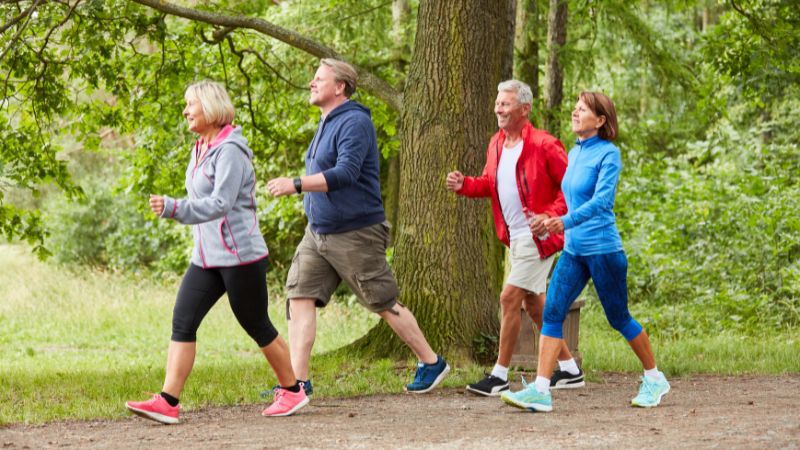Walking is one of the simplest and most effective ways to lose weight and improve overall health. It’s a low-impact exercise that can be done almost anywhere and doesn’t require special equipment. By incorporating specific strategies, you can maximize the fat-burning potential of your walks. Here are nine tips to help you burn fat more effectively while walking.
Consistency is Key

Make walking a regular part of your routine. Aim for at least 30 minutes of brisk walking most days of the week. Consistency is crucial for weight loss, as it helps to create a calorie deficit needed to shed pounds. Regular walking not only helps in burning calories but also boosts your metabolism, improves cardiovascular health, and enhances your overall fitness level. By committing to a consistent walking schedule, you establish a healthy habit that supports long-term weight management.
Increase Intensity
Incorporate intervals of faster walking or include hills in your route to boost calorie burn and challenge your muscles. Adding bursts of high-intensity walking or tackling inclines increases your heart rate and engages more muscle groups, leading to greater calorie expenditure. This technique, known as interval training, is highly effective for fat loss as it keeps your body guessing and prevents plateaus. By varying the intensity, you can maximize the benefits of your walking workouts and accelerate your weight loss progress.
Maintain Proper Form
Keep your posture upright, shoulders relaxed, and arms swinging naturally. Engage your core muscles for stability. Proper walking form not only enhances your efficiency but also helps prevent injuries. By maintaining an upright posture and engaging your core, you support better alignment and reduce the strain on your joints. Swinging your arms naturally aids in propelling your body forward and can increase the intensity of your walk, further boosting calorie burn. Focus on maintaining a steady pace and good form throughout your walk to optimize results.
Set Realistic Goals
Start with achievable targets and gradually increase the duration and intensity of your walks as you progress. Setting realistic and attainable goals is essential for maintaining motivation and tracking progress. Begin with short, manageable walks and gradually extend the time and distance as your fitness improves. Celebrate small milestones along the way to keep yourself encouraged and committed to your walking routine. By progressively challenging yourself, you build endurance and increase the effectiveness of your workouts.
Mix It Up

Vary your walking routes to keep things interesting and prevent boredom. Explore different terrains and environments. Walking the same route every day can become monotonous, leading to decreased motivation. By exploring new paths, parks, or neighborhoods, you keep your walks enjoyable and stimulating. Different terrains, such as trails, sandy beaches, or urban streets, provide varying levels of difficulty and work different muscle groups, enhancing the overall effectiveness of your walking regimen.
Stay Hydrated
Drink water before, during, and after your walk to stay hydrated and support fat-burning processes in your body. Hydration is vital for optimal performance and weight loss. Water helps regulate body temperature, lubricate joints, and transport nutrients, all of which are essential during physical activity. Staying hydrated also aids in metabolism and can help control appetite. Carry a water bottle with you and take regular sips to ensure you remain well-hydrated throughout your walk.
Incorporate Strength Training
Add bodyweight exercises like lunges, squats, and push-ups along your walking route or on rest days to build muscle and boost metabolism. Combining walking with strength training increases muscle mass, which in turn raises your resting metabolic rate. This means you’ll burn more calories even when you’re not exercising. Including exercises that target major muscle groups helps in toning and shaping your body, providing a comprehensive approach to fitness and weight loss.
Track Your Progress
Use a fitness tracker or smartphone app to monitor your steps, distance, and calorie expenditure. Seeing your progress can help keep you motivated. Tracking your activity allows you to set goals, measure achievements, and stay accountable. Many fitness apps provide detailed insights into your walking habits, helping you identify patterns and areas for improvement. Monitoring your progress visually reinforces your commitment and can inspire you to push harder and stay on track with your weight loss journey.
Prioritize Rest and Recovery

Allow your body adequate time to rest and recover between walking sessions. Proper sleep and nutrition are essential for fat loss and overall health. Rest and recovery are crucial components of any fitness program, as they enable your muscles to repair and strengthen. Ensure you get enough sleep each night and consume a balanced diet rich in nutrients to support your physical activity. Listening to your body and giving it time to recover helps prevent injuries and keeps you energized for future walks.



